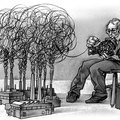Conquistadors on the beach
From The Economist print edition
| |
 | |
Spanish companies have gone global, but now trouble is brewing at home with concerns over a property crash
IT WAS the early 1980s and a wholesale fashion business was booming around the Balmes street market in Barcelona. Unlike the traditional rag trade, these firms were striving to serve local shops and boutiques rather than the big chains. One wholesaler was Isak Andic, who arrived from Turkey as a 13-year-old and started selling T-shirts to fellow students at Barcelona's American High School. Mr Andic thought he could make more money on the retail side and in 1984 opened the first Mango store in the Paseo de Gracia. It was another step in the remarkable transformation of Spanish business.
Mango is one of two highly successful Spanish clothing firms which have strutted onto the international stage—the other is the much bigger Zara, owned by the Inditex group. In terms of stores it recently overtook America's GAP to become the world's largest fashion retailer. Both firms have become case studies of post-modern businesses—design, marketing and retailing flair crossed with world-class information technology and logistics systems. Instead of using lead times of six months or so to mass-produce clothes that they hope will be fashionable, Mango and Zara pioneered “fast fashion”, in which they rush a smaller number of garments into shops within days when they spot new styles and appetites.
The two fashion companies are among a gaggle of Spanish conquistadors rapidly building global business empires. Many are much bigger than Mango and Zara, although sometimes less well-known abroad. Firms like Santander, a huge banking group, and Ferrovial, a construction giant, have spent billions buying foreign businesses. Often this has been financed with large borrowings. As a result, the Spanish stockmarket reflects a rising level of corporate debt (see chart).
 | |
And therein lies the worry. Spanish companies' overseas adventure has been boosted by the transformation of their home economy from an also-ran into one of the star performers of the European Union. That 14-year domestic expansion has, in turn, been buoyed by low interest rates and a construction and property boom that shows signs of suddenly receding. Does this mean Spain's new global champions will find themselves beached?
As if in defiance of last week's 3% plunge in Spain's stockmarket—caused by property worries—its firms have continued their global advance: Telefónica, already the world's fifth-largest telecoms firm (and Europe's largest doing both fixed and mobile telephony), moved to become a big shareholder in Telecom Italia (see article). It already has a string of overseas businesses in Latin America and Britain. And a subsidiary of Metrovacesa, a Spanish property company, bought the Canary Wharf headquarters of HSBC, a banking group, for £1.1 billion ($2.2 billion)—the biggest-ever single-property deal in Britain
Property prices are still rising in Spain, but the rate of increase is slowing. The housing market represents about half the total construction work. Much of the property is bought as second homes by the Spanish and by other Europeans, who move to Spain to enjoy the climate or to holiday and retire there. A lot of the market is speculative. So far there has been no sign of mortgage defaults hurting banks, as with the collapse in the “subprime” lending market in America, which was also fuelled by easy credit.
But the stockmarket wobble raises concerns. Spain has achieved one of the most rapid increases in wealth in the euro zone, but it remains stuck with an unbalanced economy and low domestic productivity. Its new global champions have built successful businesses, but only in certain industries. As a whole, Spanish business remains limited in its scope. If trouble is brewing at home, these companies need to be global enough to draw on markets outside Spain.
The new conquistadors mostly consist of a group of banks, builders and service companies. There is little manufacturing in Spain. Its steel mills and shipyards are relics of its pre-democratic days as a closed economy. Most of Spain's manufacturing is carried out by branch factories, such as those expanded by France's Renault and Germany's Volkswagen to take advantage of cheap labour when Spain entered the EU in 1986. But now cheaper labour is available in eastern Europe. Nor does Spain have much of a tradition in high-tech industries, although it is becoming a bigger contender in aerospace as a shareholder in the EADS group, which makes Airbus aircraft.
Take away construction and tourism (60m tourists arrive every year in a country of 43m people) and there is not much left. Moreover, tourism revenues have flattened as more foreigners now own holiday or retirement houses and so spend less on hotels. And there is only so much land (and, as important, water) for more development on the Mediterranean coast.
Yet the years spent by Spain using EU regional-development aid to build its own motorways and gleaming airports allowed it to develop businesses that could do the same thing abroad with services and infrastructure. A decade ago the government helped to promote this by offering tax relief on the value of the “goodwill” that Spanish companies pay when they take over foreign firms. That policy has since come under attack from the European Commission, but now that the international movement is under way, the tax break no longer counts for as much
 | |
The bigger motivation is to seek growth outside Spain, which if successful would help cushion Spanish companies from a domestic downturn. A lot has been achieved. The expansion started in Latin America, where Spanish businesses spent some $80 billion in the 1990s. Spanish banks, utilities and telecoms companies now challenge American firms right across Latin America. Their operations are spreading to North America, Europe and China. The advance party is often led by Spanish banks, particularly the two biggest, which originally hail from the Atlantic coast.
The city of Santander made its fortune trading with the Spanish colonies on the other side of the Atlantic. The Santander group put modern Spanish banking on the international map when in 2004, with the help of its long-standing ally, Royal Bank of Scotland, it bought Abbey, a British bank. The pair have teamed up again in a battle to take over ABN Amro, a Dutch bank. Santander is the biggest bank in the euro zone by market capitalisation, and number one in Latin America. It has interests in American retail banking, including a 25% stake in Sovereign Bancorp. In terms of profits, it ranks seventh worldwide.
BBVA has its banking roots in Bilbao. It owns Mexico's second-biggest bank and recently added to its American portfolio with a successful bid for Compass Bancshares. It has also announced a move into Asia through a strategic alliance with the CITIC group, a Hong Kong conglomerate that owns a bank in mainland China. BBVA has spent €1 billion ($1.4 billion) to take nearly 5% of China CITIC Bank and a 15% stake of CITIC International Holdings.
The Spanish banks have been helped in their advance by the supremacy of their IT systems. They have made great technological leaps in the past two decades with systems that build profiles of customers so that they can see who can afford to take on more loans. Francisco González, chairman of BBVA, says he does not run a bank but “an industrial financial company”.
“The bank of the future will be a distribution-services company,” predicts Mr González. Last week Santander reported a 21% increase in first-quarter net profits to €1.8 billion largely on the back of a strong expansion in loans and services fees in Europe and Latin America. Mr González believes the bank will make money from knowledge it gathers about customers to sell them products such as health care, education and even funerals.
How did Spain produce such able bankers? David Allen of the Instituto de Empresa, a business school in Madrid, identifies a combination of factors. Spanish education improved vastly in the 1960s and 1970s, providing a growing pool of talent. Given the lack of industry in which to find well-paid jobs, those who wanted more than work in construction or tourism on the Costas flocked to banking.
The other important factor was competition: foreign banks were allowed to enter Spain in the late 1970s, causing local banks to sharpen their strategies and invest more in technology. Santander and BBVA, together with Telefónica, account for more than a third of the Spanish stockmarket's total capitalisation. These three companies are also among the most actively traded stocks in the euro zone.
Following the banks were the construction firms. They not only diversified geographically from Spain, but also moved into related industries. The most swashbuckling is Ferrovial, which started out building Spanish railways in the 1950s. Its £10.1 billion takeover last June of BAA, the company that owns three of London's airports and four more elsewhere in Britain, was a spectacular deal. With two allies from Canada and Singapore, it ended up with 62% of BAA's equity. The British airports group now accounts for more than half of Ferrovial's profits—and some 70% of its €33 billion of debt, according to calculations by BPI, a Portuguese bank. Ferrovial was able to borrow heavily and put up barely £580m of its own money to take control of a company with a lock on Britain's air-travel industry through its ownership of Heathrow, the world's busiest international airport.
The justification for such a high level of debt is that airports are like public utilities with a predictable income and a pricing regime (in Britain, at least) that guarantees a reasonable return on capital. Indeed, British regulations favour capital spending, which means that BAA has a big pipeline of construction projects ahead of it.
Spanish businesses have spent nearly $60 billion snapping up British firms, culminating in the recent purchase of Scottish Power by Iberdrola, a Spanish utility. Britain's open economy has made it a happy hunting ground, because the Spanish encounter less opposition than in France and Italy. The Abertis services company last year had to drop its attempt to acquire an Italian motorway company because the government there changed the rules to make it less attractive. Now the French are shaking in their shoes over a bid by Sacyr Vallehermoso, a Spanish construction company, for the historic Eiffage construction group, which built the Eiffel Tower.
The Spanish are finding opportunities farther afield, too. Rafael del Pino, Ferrovial's boss, has teamed up with Australia's Macquarie Group to buy two motorways in America, the Chicago Skyway and the Indiana Toll Road, through its quoted subsidiary Cintra (in which it holds 62%); it also manages a motorway in Texas with the state government. Altogether Ferrovial operates 22 motorway concessions covering 2,500km (1,553 miles). The Spanish group also bought Amey, a British services and project-management business that maintains three London Underground lines. Ferrovial sold its housing and property business for €1.6 billion, plus €600m of debt, last December—apparently with perfect timing.
Other housebuilders have spread their risks. Acciona, another construction company, is, with the help of Italy's Enel, buying control of the biggest Spanish electricity company, Endesa, and in the process it is fending off a hostile bid from Germany's E.on. The attraction for José Manuel Entrecanales, who succeeded his father at the top of the company three years ago, is Endesa's hydroelectric dams and its 1,800MW of wind turbines. Mr Entrecanales points to calculations from the International Energy Agency that show hydroelectric and wind power generation each growing by more than 5% on average for the foreseeable future, compared with average growth of less than 2% for all sources of energy.
Mr Entrecanales is now chasing Iberdrola to become the world leader in wind farms. By 2009 he aims to have nearly 8,000MW of wind-turbine capacity. The company owns wind farms in Alberta, Germany, France and Australia, plus a joint venture in China. Even before its acquisition of Endesa, Acciona's energy business had grown to 38% of earnings by the end of last year, compared with less than 12% for its property business.
| |
 | |
Reflecting a shaky building site |
Energy has also attracted the attentions of Sacyr Vallehermoso, a construction firm with a 20% stake in Repsol YPF, a Spanish oil company with interests in Argentina, the Caribbean, the Gulf of Mexico and North Africa. The dealmaker is Luis del Rivero, boss of Sacyr, who has seen the stockmarket value of his construction and services company rise nearly fourfold in the past three years. Repsol operates in 30 countries, often working with national oil companies. But Mr del Rivero has his eye on Repsol's strong position in natural gas.
Privately, a number of Spanish bankers and managers worry that some of the ambitions of Spain's big companies could be riding on too much borrowed money. Their loans are sometimes backed by their stakes in other quoted companies. This means a big fall in the Spanish stockmarket, triggered by a property downturn, could have a damaging effect even to companies that have diversified.
For Spain as a whole, that is not the only concern. Martin Varsavsky, an Argentine who founded three high-tech companies in Spain, thinks that outside the big companies there is a lack of entrepreneurship. He blames neglect of science in the Franco era: he points out that Israel, with a population one-tenth of Spain's, has more business start-ups. He thinks Spaniards are generally risk-averse.
Mr Varsavsky's latest venture is a wireless-internet business called FON. Customers buy FON's routers and become “Foneros”. They get free Wi-Fi access in return for allowing free access to their router by other Foneros. He hopes to build a global network of at least 4m customers pooling their bandwidth. Such ventures have been tried before with no success, but Mr Varsavsky is backed by powerful forces, including Google and Sequoia Capital, a Californian venture-capital fund.
If Mr Varsavsky is right, Spain needs more local innovators. In many countries these tend to gather in business “clusters”, as in Silicon Valley. The nearest thing Spain has to a cluster—apart from its holiday resorts—is the talent that pours out of its famous design school in Barcelona. Both Mango and Inditex have some of their design studios in the city.
Both the fast-fashion champions have operations spread around large parts of the world. Mango follows a modern outsourcing model. It has 880 stores in 83 countries, fed by garments that speed through its logistics centres at a rate of 30,000 an hour. These generate annual sales of €1.1 billion—three-quarters of that outside Spain.
Mango's business model consists of franchises, completely outsourced production in Asia, and sophisticated IT and logistics systems to ensure goods arrive on the shelves in ten days on a sale-or-return policy. Mango's main role is to design garments and arrange their distribution. Its first overseas expansion was to nearby Portugal in 1992. A quarter of its 6,000-strong labour force is employed in its Barcelona headquarters.
Inditex, based in La Coruña in Galicia, a region in north-western Spain, does the clever bits of production—cutting and finishing—in its own factories in Spain, Portugal and North Africa. It has 3,207 shops in 64 countries. About a third are Zara stores, and the rest Inditex's other brands, such as Pull and Bear, and Massimo Dutti. Inditex has tripled sales in six years to over €8 billion, some 60% of it abroad.
Amancio Ortega, Inditex's founder, became Spain's richest man after the heavily over-subscribed stock was floated on the stockmarket in 2001 and soared by half in 12 months. Today the fit-looking 71-year-old still appears in Zara's offices most days after his two-hour workout in the gym. But the chief executive charged with rolling out new stores at a rate of over 400 a year is Pablo Isla. The first Zara store has just opened in Beijing. And with only 24 outlets in America, it still has scope for huge expansion there. “The 1970s was all about opening in Galicia,” says Mr Isla. “The 1980s and 1990s were about Spain and Europe. But since 2000 we have been pursuing true internationalisation.”
Those Spanish companies that have boldly escaped the confines of their home market are betting they can survive a domestic downturn despite their huge debts. But entrepreneurs are still needed to broaden the base of Spanish business or there will not be much else beyond tourism. As Ana Patricia Botín, head of Banesto, a retail bank in the Santander group, says: “It is all very well being the Florida of Europe, but it would be nice to be the California as well.”





